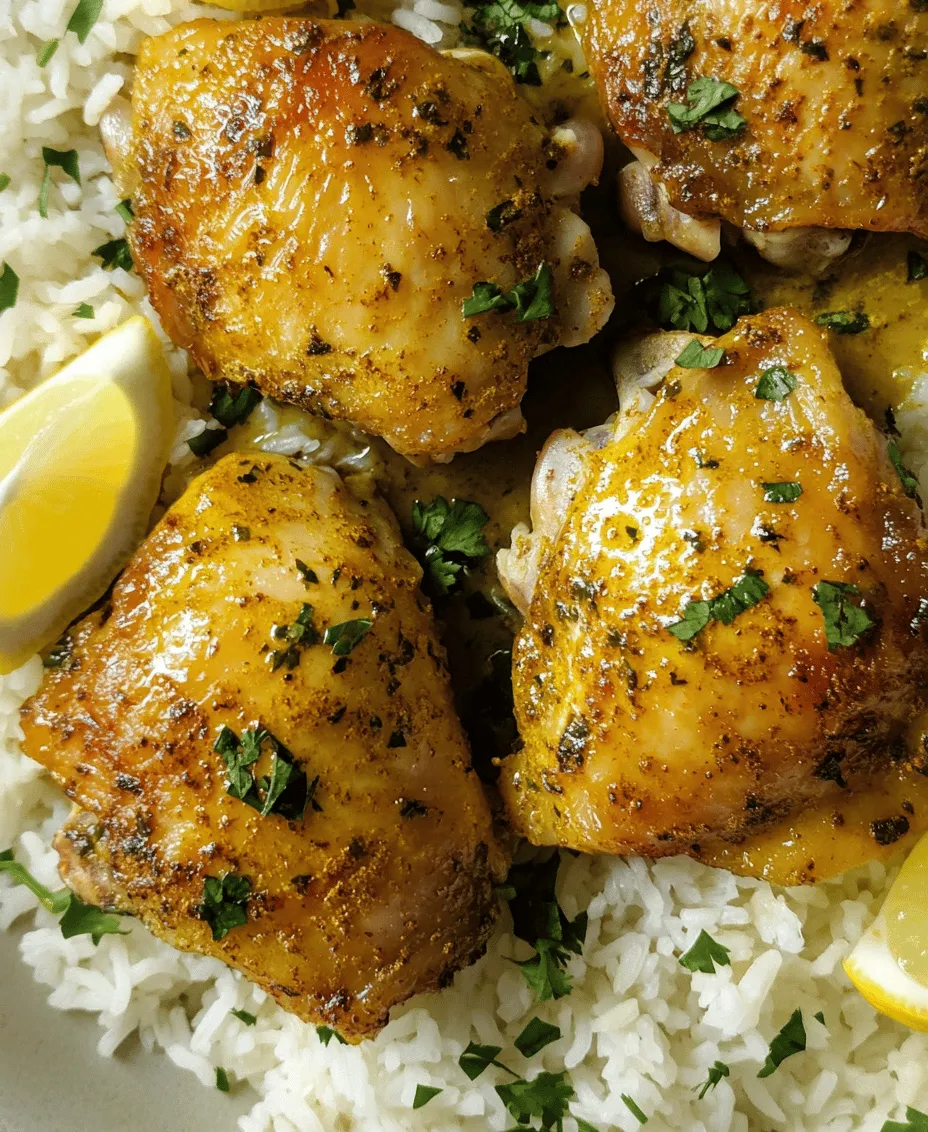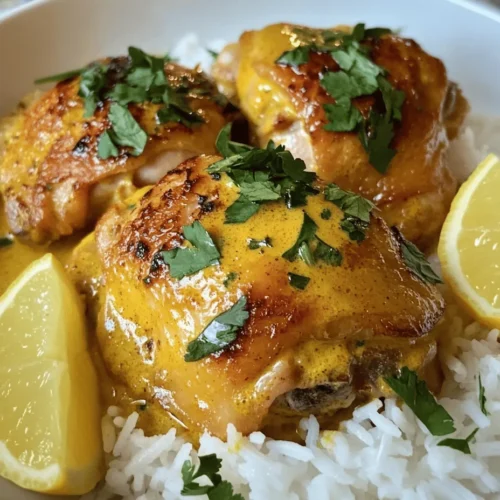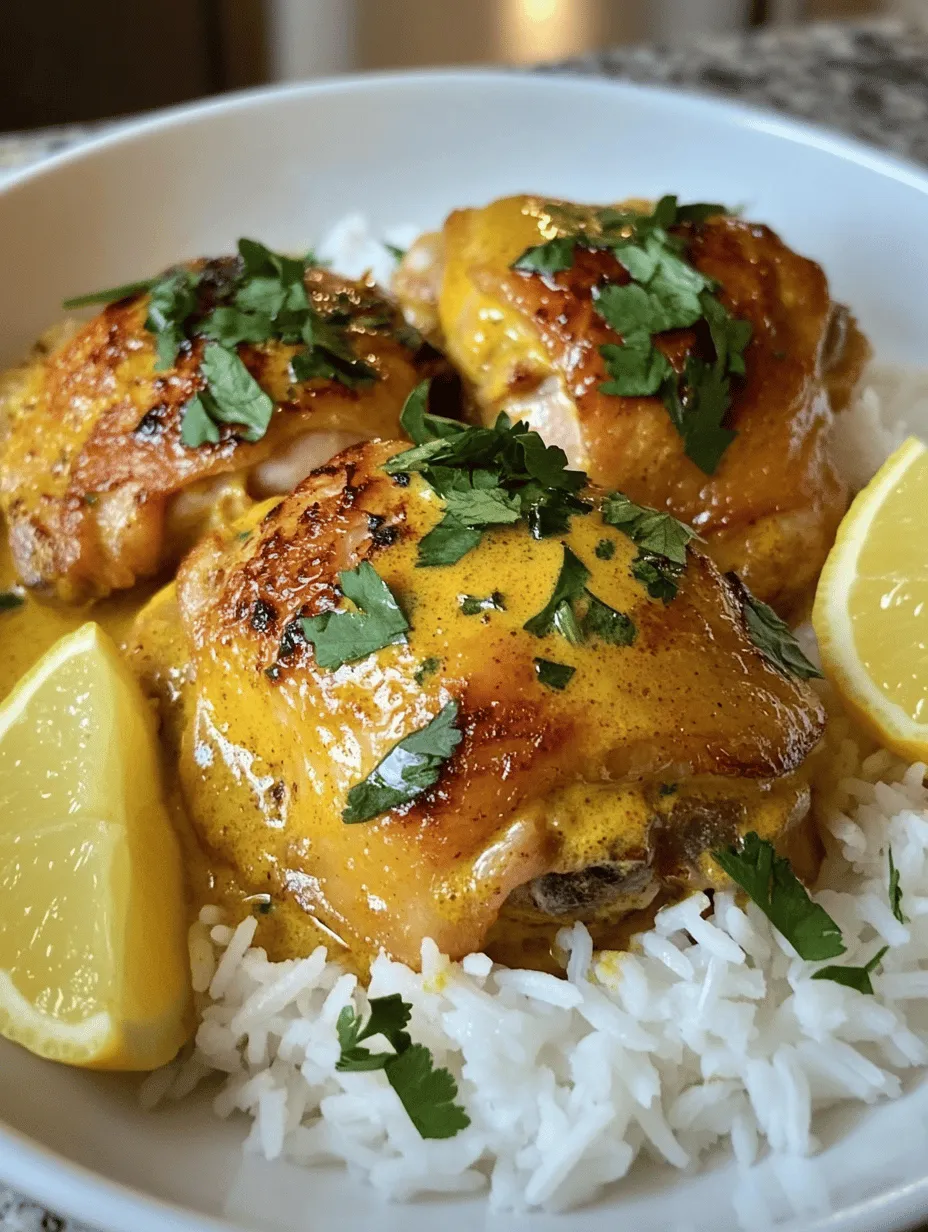Introduction to Kuku Paka: A Creamy Coconut Chicken Delight
Kuku Paka is a dish that beautifully embodies the culinary spirit of East Africa, particularly the coastal regions of Kenya and Tanzania. This creamy coconut chicken delight is a favorite among many, celebrated for its rich flavors, comforting textures, and the way it brings people together. The dish seamlessly combines tender chicken with a luscious coconut sauce, infused with aromatic spices that tantalize the taste buds. Whether it’s a family gathering, a festive celebration, or a cozy dinner at home, Kuku Paka is sure to impress everyone at the table.
As we delve into the depths of Kuku Paka, we will uncover its intriguing origins, the cultural influences that shaped it, and the significance of its key ingredients. The use of coconut, in particular, not only enhances the dish’s flavor but also reflects the broader culinary traditions of the East African coast. Join us on this culinary journey as we explore the essence of Kuku Paka, and prepare to create a dish that is as rich in history as it is in taste.
Understanding Kuku Paka: A Culinary Journey
The Origins of Kuku Paka
Kuku Paka traces its roots to the Swahili culture, influenced by a blend of African, Arab, and Indian culinary traditions. The Swahili people, residing along the East African coast, have historically been traders, and their cuisine reflects this diversity. The name “Kuku Paka” translates to “chicken in coconut” in Swahili, aptly describing the dish’s core components. While the exact origins of Kuku Paka are difficult to pinpoint, it is believed to have evolved from traditional coastal cooking practices, where coconut milk was a staple ingredient.
In its early days, Kuku Paka was enjoyed primarily by coastal communities, often prepared for special occasions and gatherings. Over time, as the dish gained popularity, it spread beyond its coastal origins, making its way into homes and restaurants across East Africa and beyond. Today, Kuku Paka is not just a dish; it is a symbol of cultural pride and culinary heritage, showcasing the rich flavors and ingredients that define East African cuisine.
The Significance of Coconut in East African Cooking
Coconut is more than just a flavorful ingredient in Kuku Paka; it plays a vital role in the culinary landscape of East Africa. Known for its versatility, coconut is used in various forms—fresh, dried, or as coconut milk—in numerous traditional dishes. The nutritional benefits of coconut are significant; it is rich in healthy fats, essential vitamins, and minerals, making it a valuable addition to the diet.
In East African cooking, coconut milk is particularly cherished for its creamy texture and ability to enhance the flavors of meats, vegetables, and seafood. It adds a velvety richness to dishes while balancing out the heat of spices. In Kuku Paka, coconut milk is the star ingredient, transforming the chicken into a succulent and comforting dish that is both aromatic and satisfying.
Ingredient Breakdown: What Makes Kuku Paka Special
Fresh and Flavorful Ingredients
At the heart of Kuku Paka lies a selection of fresh and flavorful ingredients that contribute to its unique taste. The main ingredient, chicken thighs, is preferred for its tenderness and ability to absorb flavors. Chicken thighs are juicy and flavorful, making them an ideal choice for this dish. The use of quality chicken is essential; sourcing fresh, organic chicken will yield the best results.
Next comes coconut milk, which provides the creamy base for the dish. When selecting coconut milk, look for products that contain minimal additives and preservatives to ensure you’re getting the purest flavor. For the best experience, consider using full-fat coconut milk; its richness helps create a luscious sauce that clings beautifully to the chicken.
The dish is further enhanced with a variety of spices, including curry powder, turmeric, and cayenne pepper. These spices not only contribute depth of flavor but also add vibrant color to the dish. When using spices, freshness is key; always opt for whole spices when possible, and grind them just before use to release their essential oils and flavors.
The Role of Aromatics
Aromatics play an indispensable role in building the flavor profile of Kuku Paka. Onions, garlic, and ginger form the aromatic base of the dish, providing a fragrant foundation that enhances the overall experience. Onions bring sweetness and depth, while garlic and ginger add a pungent warmth that is characteristic of many East African dishes.
When selecting aromatics, freshness is crucial. Look for firm, unblemished onions, plump garlic cloves, and vibrant ginger root. These ingredients will not only elevate the flavor of your Kuku Paka but will also create an enticing aroma as they sauté.
Spice Profiles: Creating Depth of Flavor
The spice blend used in Kuku Paka is what truly sets it apart from other chicken dishes. Curry powder is the primary seasoning, providing a warm, earthy flavor that complements the coconut milk beautifully. Turmeric adds a golden hue and a mild, slightly bitter taste, while cayenne pepper introduces a touch of heat.
Adjusting the spice levels to suit your personal preference is easy. If you prefer a milder flavor, you can reduce the amount of cayenne pepper or choose a curry powder that is less spicy. Conversely, if you enjoy a bit of heat, feel free to amp up the cayenne to your liking. Experimenting with spice levels allows you to personalize Kuku Paka to your taste.
Step-by-Step Cooking Instructions
Preparing the Chicken: Marination for Flavor
The first step in creating a delicious Kuku Paka is marinating the chicken. Marination is a crucial step that infuses the chicken with flavor and ensures that it remains tender during cooking. Start by cutting the chicken thighs into bite-sized pieces for even cooking. In a mixing bowl, combine your chicken with a blend of spices, including salt, curry powder, and a splash of coconut milk. Allow the chicken to marinate for at least 30 minutes, although longer is better if you have the time—up to 4 hours or even overnight in the refrigerator for maximum flavor penetration.
During the marination process, the chicken absorbs the spices and coconut milk, enhancing its taste and texture. Make sure to cover the bowl with plastic wrap or a lid to prevent any cross-contamination in your refrigerator. This step not only adds flavor but also helps in tenderizing the meat, making for a juicy and succulent dish.
Sautéing Aromatics: Building the Base
Once the chicken is marinated, it’s time to build the aromatic base for Kuku Paka. In a large skillet or pot, heat a generous amount of oil over medium heat. A neutral oil, such as vegetable or canola oil, works best, but you can also use coconut oil for added flavor. Once the oil is hot, add chopped onions and sauté them until they become translucent and fragrant.
Next, incorporate minced garlic and grated ginger into the pan, stirring frequently to prevent burning. The goal is to create a fragrant mixture that will serve as the backbone of the dish. Sautéing these aromatics releases their essential oils, creating a rich and inviting aroma that sets the stage for the rest of the cooking process.
To achieve the perfect aromatic base, pay attention to the heat. If the onions begin to brown too quickly, reduce the heat slightly. You want them to soften and become sweet without burning, as burnt aromatics can impart unwanted bitterness to your dish.
Browning the Chicken: Achieving the Right Texture
After the aromatics have reached the desired level of fragrance and softness, it’s time to add the marinated chicken to the pan. Use a slotted spoon to transfer the chicken, allowing excess marinade to drip off before adding it to the hot oil. This method ensures that the chicken browns properly rather than steaming in the pan.
When adding the chicken, do not overcrowd the pan; it’s better to work in batches if necessary. Browning the chicken is crucial for flavor development, as the Maillard reaction—the process that occurs when food is cooked at high temperatures—creates a depth of flavor that enhances the overall dish. Cook the chicken for about 5-7 minutes on each side, or until it is nicely browned and cooked through.
To check for doneness, use a meat thermometer to ensure the internal temperature of the chicken reaches 165°F (75°C). Properly browned chicken will develop a beautiful golden crust that adds to the visual appeal and flavor of Kuku Paka.
As we continue with this recipe, we will explore the next steps to complete the dish, ensuring that you create a delectable Kuku Paka that is both flavorful and satisfying. Stay tuned as we dive deeper into the cooking process, where the magic of coconut milk and spices come together to create a culinary masterpiece.

Creating the Sauce: The Heart of Kuku Paka
The sauce is the essence of Kuku Paka, transforming simple ingredients into a symphony of flavors. To begin, combine the rich coconut milk, savory chicken broth, and a dollop of tomato paste in a large saucepan. The coconut milk provides a creamy base, while the chicken broth adds depth and umami. The tomato paste introduces a subtle acidity that balances the richness of the coconut.
Combining Coconut Milk, Chicken Broth, and Tomato Paste
Start by pouring one can (about 400 ml) of full-fat coconut milk into your saucepan. Then add 1 cup of chicken broth, which can be homemade or store-bought for convenience. Stir in 2 tablespoons of tomato paste, blending it well with the coconut milk and broth. This combination creates a luscious, velvety sauce that will envelop your chicken beautifully.
Tips for Achieving the Right Consistency in the Sauce
To ensure your sauce achieves the right consistency, pay attention to the proportions of coconut milk to broth. If you prefer a thicker sauce, you can reduce the amount of chicken broth or enhance the sauce with a slurry made from cornstarch mixed with water. Similarly, if it’s too thick, gradually add more broth or water until you reach your desired texture. Remember that the sauce will thicken slightly as it simmers, so aim for a pourable consistency at this stage.
The Simmering Process: Allowing Flavors to Meld
Once your sauce is ready, it’s time to bring all the elements together. Add the seasoned chicken pieces to the sauce, ensuring they are fully submerged. Cover the saucepan and bring the mixture to a gentle simmer over medium heat.
How Long to Simmer and Why It’s Crucial for Tenderness
Allow the chicken to simmer for approximately 25-30 minutes. This simmering process is crucial as it allows the chicken to absorb the rich flavors of the sauce while becoming tender and juicy. Cooking at a gentle simmer prevents the chicken from toughening, ensuring that each bite remains succulent.
Tips for Maintaining Moisture and Preventing Sticking
To keep your chicken moist and prevent sticking, stir the sauce occasionally, making sure to scrape any bits that may cling to the bottom of the pan. Keep the lid on during simmering to trap steam, which helps cook the chicken evenly. If you notice the sauce thickening too quickly, add a splash of chicken broth or water to maintain moisture.
Final Adjustments: Perfecting the Dish
As your Kuku Paka nears completion, it’s time to make final adjustments to ensure the dish is just right.
How to Adjust the Sauce Thickness and Seasoning
To adjust the thickness of your sauce, utilize the same method as before by adding broth for a thinner consistency or a cornstarch slurry for thickening. When it comes to seasoning, taste the sauce as it simmers and adjust accordingly. A pinch of salt can enhance the flavors, while a squeeze of lime can add brightness. Consider also adding spices like cayenne pepper for heat or a dash of soy sauce for umami.
Importance of Tasting Throughout the Cooking Process
Tasting your dish at various stages is essential. It not only helps you adjust flavors but also allows you to connect with the cooking process, ensuring that the final product meets your palate’s preferences. Remember that the flavors will deepen as the dish cooks, so enjoy the experience and refine it to your liking.
Serving Suggestions: Elevating Your Kuku Paka Experience
Now that your Kuku Paka is ready, it’s time to think about how to serve this delightful dish. The way you present Kuku Paka can elevate the dining experience and highlight the vibrant flavors.
Ideal Accompaniments
Kuku Paka is traditionally served with sides that complement its rich, creamy sauce.
Traditional Sides: Rice and Ugali
Serve Kuku Paka over a bed of fluffy white rice or alongside ugali, a staple East African dish made from maize flour. The neutral flavors of rice or ugali absorb the creamy sauce beautifully, making for a satisfying meal. For an added touch, consider offering a side of sautéed greens or a fresh salad to balance the richness of the dish.
Suggestions for Garnishes Like Cilantro and Citrus Wedges
Garnishing can enhance both the taste and presentation of your Kuku Paka. Fresh cilantro adds a burst of color and freshness, while citrus wedges (such as lime or lemon) can be squeezed over the dish just before serving to brighten the flavors. You might also consider sprinkling some toasted coconut flakes for texture and visual appeal.
Presentation Tips
When it comes to plating, consider the visual impact of your dish.
Creative Plating Ideas to Enhance Visual Appeal
Use a wide, shallow bowl to serve the Kuku Paka, allowing the sauce to spread elegantly around the chicken. Layer the rice or ugali in the center and generously ladle the creamy sauce over the top. Add a sprig of cilantro and a wedge of lime on the side for a pop of color. For a rustic touch, consider serving the dish in a traditional earthenware pot or a wooden bowl.
Importance of Garnishing for Flavor and Aesthetics
Garnishing not only elevates the aesthetic but also enhances the flavor profile of your dish. A sprinkle of chili flakes can add a hint of heat, while freshly cracked black pepper provides a robust aroma. Remember that the visual appeal of a dish can enhance the dining experience, making it more inviting and enjoyable for your guests.
Nutritional Information: A Balanced Meal
Kuku Paka is not just a delightful culinary experience; it also offers a range of nutritional benefits.
Nutritional Breakdown of Kuku Paka
A typical serving of Kuku Paka contains approximately 400-500 calories, depending on the portion size and accompaniments. The dish is rich in protein, thanks to the chicken, which provides essential amino acids necessary for muscle repair and growth. The coconut milk contributes healthy fats, particularly medium-chain triglycerides (MCTs), which can offer numerous health benefits, including improved metabolism and energy levels.
Overview of Calories, Protein, and Essential Nutrients
In addition to protein and healthy fats, Kuku Paka also contains vitamins and minerals from the ingredients used, including vitamin C from tomatoes and beneficial antioxidants from spices. This makes it a well-rounded meal that can support overall health.
Health Benefits of the Ingredients Used
The use of coconut milk not only enhances flavor but also provides a source of lauric acid, known for its antimicrobial properties. Chicken is an excellent source of lean protein, while spices like garlic and ginger can aid digestion and boost the immune system. This dish, when paired with whole grains or vegetables, offers a balanced meal option that satisfies hunger and nourishes the body.
Customizing for Dietary Preferences
Kuku Paka can be easily adapted to meet various dietary preferences.
Options for Making Kuku Paka Gluten-Free or Dairy-Free
To make Kuku Paka gluten-free, ensure that all ingredients, including the chicken broth, are certified gluten-free. For a dairy-free version, the recipe is inherently suitable as it uses coconut milk instead of cream.
Substitutions for Various Dietary Restrictions
For those who prefer a vegetarian or vegan version, consider substituting chicken with firm tofu or chickpeas. Use vegetable broth in place of chicken broth and ensure that the tomato paste contains no added sugars or preservatives. These simple adjustments maintain the integrity of Kuku Paka while accommodating different dietary needs.
Cultural Insights: Kuku Paka in Everyday Life
Kuku Paka is not just a dish; it embodies the spirit of East African cuisine and culture.
Kuku Paka in Family Gatherings and Celebrations
Traditionally, Kuku Paka is served during family gatherings and special occasions, reflecting the warmth of East African hospitality. It is a popular dish at weddings, communal feasts, and festive celebrations, symbolizing togetherness and shared joy. Many families have their own cherished recipes, passed down through generations, each adding a unique touch to this beloved meal.
Personal Stories and Anecdotes Related to Kuku Paka
Food often carries stories, and Kuku Paka is no different. Many people recall fond memories of gathering around the table with family, sharing laughter and stories while enjoying this creamy chicken delight. These personal anecdotes enhance the dish’s significance, making it not just about the food but the connections and traditions it fosters.
The Global Appeal of Kuku Paka
As the world grows more interconnected, Kuku Paka has made its way beyond the borders of East Africa, gaining popularity on the global stage.
How Kuku Paka Has Gained Popularity Beyond East Africa
The dish’s unique flavors and comforting nature have attracted food enthusiasts worldwide. In various international food festivals and restaurants, Kuku Paka stands out as a must-try dish, drawing people into the rich culinary traditions of East Africa.
Fusion Adaptations and Modern Interpretations
Many chefs and home cooks have taken to creating fusion adaptations of Kuku Paka, experimenting with different proteins or adding contemporary twists, such as incorporating seasonal vegetables or using different types of coconut milk. These modern interpretations keep the dish relevant while honoring its traditional roots.
Conclusion: Embracing the Richness of Kuku Paka
Kuku Paka is more than just a meal; it is a cultural experience that captures the essence of East African hospitality and culinary artistry. By preparing this creamy coconut chicken delight, you not only indulge in a delicious dish but also connect with a rich heritage. Whether enjoyed at a family gathering or a quiet dinner at home, Kuku Paka is sure to bring warmth and joy to your table. Embrace the flavors, share the stories, and savor every bite of this remarkable dish.



